| # | Portrait | Name
(Birth–Death) | Reigned | Note | Sources |
|---|
| 37 | 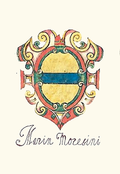 | Domenico Morosini
(died February 1156) | 1148–1156 | | |
| 38 | 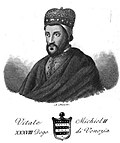 | Vitale II Michiel
(died 1172) | 1156–1172 | Murdered | |
| 39 |  | Sebastiano Ziani
(1178) | 1172–1178 | Resigned to a monastery, died three days later | |
| 40 |  | Orio Mastropiero
(died 13 June 1192) | 1178–1192 | | |
| 41 | 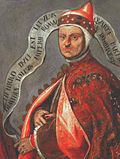 | Enrico Dandolo
(1107 – May/June 1205) | 21 June 1192 – June 1205 | | |
| 42 |  | Pietro Ziani
(died 13 March 1230) | 1205–1229 | Resigned in February 1229 | |
| 43 | 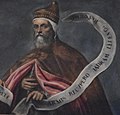 | Jacopo Tiepolo
(died 19 July 1249) | 1229–1249 | | |
| 44 |  | Marino Morosini
(1181– January 1, 1253) | 1249–1253 | | |
| 45 | 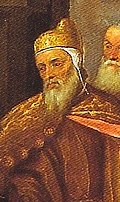 | Reniero Zeno
(died 7 July 1268) | 1 January 1253 – 7 July 1268 | | |
| 46 | 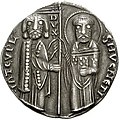 | Lorenzo Tiepolo
(died 15 August 1275) | 1268–1275 | | |
| 47 | 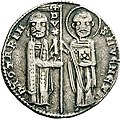 | Jacopo Contarini
(1194–1280) | 1275–1280 | | |
| 48 |  | Giovanni Dandolo
(died 2 November 1289) | 31 March 1280 – 2 November 1289 | | |
| 49 |  | Pietro Gradenigo
(c. 1251 – 14 August 1311) | 1289–1311 | | |
| 50 |  | Marino Zorzi
(c. 1231 – 3 July 1312) | 1311–1312 | | |
| 51 |  | Giovanni Soranzo
(1240 – 31 December 1328) | 1312–1328 | | |
| 52 |  | Francesco Dandolo
(died 1339) | 1329–1339 | | |
| 53 |  | Bartolomeo Gradenigo
(1263 – 28 December 1342) | 7 November 1339 – 28 December 1342 | | |
| 54 |  | Andrea Dandolo
(1306 – 7 September 1354) | 1343 – 7 September 1354 | | |
| 55 |  | Marino Faliero
(1274 – 17 April 1355) | 11 September 1354 – 15 April 1355 | Convicted of treason, executed and condemned to damnatio memoriae . Age c.80/81 | |
| 56 |  | Giovanni Gradenigo
(c. 1280 – 8 August 1356) | 21 April 1355 – 8 August 1356 | Age c.75/76 | |
| 57 |  | Giovanni Dolfin
(c. 1303 – 12 July 1361) | August 13, 1356 – 12 July 1361 | Age c. 53/58 | |
| 58 |  | Lorenzo Celsi
(c. 1310 – 18 July 1365) | 16 July 1361 – 18 July 1365 | Age c. 51/55 | |
| 59 |  | Marco Cornaro
(c. 1286 – 13 January 1368) | Late July/Early August 1365 – 13 January 1368 | Age c. 79/82 | |
| 60 |  | Andrea Contarini
(c. 1300/1302 – 5 June 1382) | 1367 – 5 June 1382 | Age c. 67/82 | |
| 61 |  | Michele Morosini
(1308 – 16 October 1382) | 10 June 1382 – 16 October 1382 | Age c. 74/74 | |
| 62 | 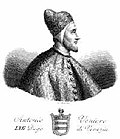 | Antonio Venier
(c. 1330 – 23 November 1400) | Late October 1382 – 23 November 1400 | Age c. 52/70 | |
| 63 | 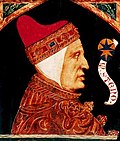 | Michele Steno
(1331 – 26 December 1413) | 1 December 1400 – 26 December 1413 | Age c. 69/82 | |
| 64 |  | Tommaso Mocenigo
(1343– 4 April 1423) | Early January 1414 – 4 April 1423 | Age c. 71/80 | |
| 65 |  | Francesco Foscari
(19 June 1373 – 1 November 1457) | 15 April 1423 – 22 October 1457 | His reign was the longest of all Doges in Venetian history. Was forced to abdicate by the Council of Ten. Age 49/84 | |
| 66 |  | Pasquale Malipiero
(1392 – 5 May 1462) | 30 October 1457 – 5 May 1462 | Age c. 65/70 | |
| 67 |  | Cristoforo Moro
(1390 – 10 November 1471) | Mid to Late May 1462 – 10 November 1471 | Age c. 72/81 | |
| 68 |  | Nicolò Tron
(c. 1399 – 28 July 1473) | Late November 1471 – 28 July 1473 | Age c. 72/74 | |
| 69 |  | Nicolò Marcello
(c. 1399 – 1 December 1474) | 13 August 1473 – 1 December 1474 | Age c. 74/75 | |
| 70 |  | Pietro Mocenigo
(3 January 1406– 23 February 1476) | 14 December 1474 – 23 February 1476 | Age 68/70 | |
| 71 |  | Andrea Vendramin
(1393 – 5 May 1478) | Early to Mid March 1476 – 5 May 1478 | Age c. 83/85 | |
| 72 | 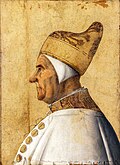 | Giovanni Mocenigo
(1409 – 4 November 1485) | Mid to Late May 1478 – 4 November 1485 | Age c. 69/76 | |
| 73 | 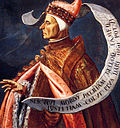 | Marco Barbarigo
(c. 1413 – 14 August 1486) | Mid to Late November 1485 – 14 August 1486 | Age c. 72/73 | |
| 74 |  | Agostino Barbarigo
(3 June 1419 – 20 September 1501) | Late August/Early September 1486 – 20 September 1501 | Age 67/82 | |
| 75 |  | Leonardo Loredan
(16 November 1436 – 22 June 1521) | 13 October 1501 – 22 June 1521 | Age 64/84 | |
| 76 | 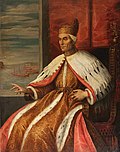 | Antonio Grimani
(28 December 1434 – 7 May 1523) | Early July 1521 – 7 May 1523 | Age 86/88 | |
| 77 |  | Andrea Gritti
(17 April 1455 – 28 December 1538) | 20 May 1523 – 28 December 1538 | Age 68/83 | |
| 78 | 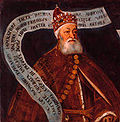 | Pietro Lando
(1462 - 9 November 1545) | Late December 1538/Early January 1539 – 9 November 1545 | Age c. 76/83 | |
| 79 | 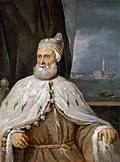 | Francesco Donato
(c. 1468–1553) | Late November 1545 – 23 May 1553 | Age c. 77/85 | |
| 80 | 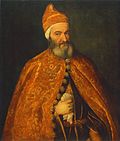 | Marcantonio Trivisan
(c. 1475 – 31 May 1554) | Early June 1553 – 31 May 1554 | Age c. 78/79 | |
| 81 | 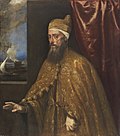 | Francesco Venier
(29 May 1489 - 2 June 1556) | 11 June 1554 – 2 June 1556 | Age 65/67 | |
| 82 | 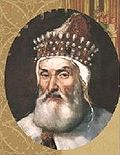 | Lorenzo Priuli
(1489 – 17 August 1559) | Mid to Late June 1556 – 17 August 1559 | Age c. 67/70 | |
| 83 |  | Girolamo Priuli
(1486 – 4 November 1567) | 1 September 1559 – 4 November 1567 | Age c. 73/81 | |
| 84 |  | Pietro Loredan
(1481 – 3 May 1570) | 29 November 1567 – 3 May 1570 | Age c. 86/89 | |
| 85 |  | Alvise I Mocenigo
(26 October 1507 – 4 June 1577) | Mid to Late May 1570 – 4 June 1577 | Age 62/69 | |
| 86 |  | Sebastiano Venier
(c. 1496 – 3 March 1578) | 11 June 1577 - 3 March 1578 | Age c. 81/82 | |
| 87 |  | Nicolò da Ponte
(15 January 1491 – 30 July 1585) | 3 March 1578 – 30 July 1585 | * There are references to a long, drawn out election process requiring 44 votes, but the appointment date matches the date of death of the previous Doge who held a Life term and served until death. This is unusual as most election appointments are between 1 and 3 weeks following the passing of the previous Doge (averaging around 2 weeks). Age 87/94 | |
| 88 |  | Pasquale Cicogna
(27 May 1509 - 2 April 1595) | Early to Mid August 1585 – 2 April 1595 | Age 76/85 | |
| 89 | 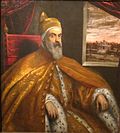 | Marino Grimani
(1 July 1532 – 25 December 1605) | 26 April 1595 – 25 December 1605 | Age 62/73 | |
| 90 |  | Leonardo Donato
(12 February 1536 – 16 July 1612) | 10 January 1606 – 16 July 1612 | Age 69/76 | |
| 91 |  | Marcantonio Memmo
(11 November 1536 – 31 October 1615) | 24 July 1612 – 31 October 1615 | Age 75/78 | |
| 92 |  | Giovanni Bembo
(21 August 1543 – 16 March 1618) | 2 December 1615 – 16 March 1618 | Age 72/74 | |
| 93 |  | Nicolò Donato
(28 January 1539 – 8 May 1618) | 5 April 1618 – 8 May 1618 | Age 79/79 | |
| 94 |  | Antonio Priuli
(10 May 1548 – 12 August 1623) | 17 May 1618 – 12 August 1623 | Age 70/75 | |
| 95 |  | Francesco Contarini
(28 November 1556 – 6 December 1624) | 8 September 1623 – 6 December 1624 | Age 66/68 | |
| 96 |  | Giovanni I Cornaro
(11 November 1551 – 23 December 1629) | 24 January 1625 – 23 December 1629 | Age 73/78 | |
| 97 |  | Nicolò Contarini
(26 September 1553 – 2 April 1631) | 18 January 1630 – 2 April 1631 | Age 76/77 | |
| 98 | 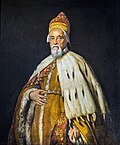 | Francesco Erizzo
(18 February 1566 – Venice, 3 January 1646) | 10 April 1631 – 3 January 1646 | Age 65/79 | |
| 99 | 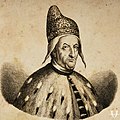 | Francesco Molin
(21 April 1575 – 27 February 1655) | 20 January 1646 – 27 February 1655 | Age 70/79 | |
| 100 |  | Carlo Contarini
(5 July 1580 – 1 May 1656) | 27 March 1655 – 1 May 1656 | Age 74/75 | |
| 101 | 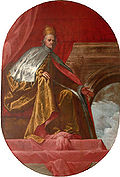 | Francesco Cornaro
(6 March 1585 – 5 June 1656) | 17 May 1656 – 5 June 1656 | Age 71/71 | |
| 102 |  | Bertuccio Valier
(1 July 1596 – 29 March 1658) | 15 June 1656 – 29 March 1658 | Age 59/61 | |
| 103 |  | Giovanni Pesaro
(1 September 1589 – 30 September 1659) | 8 April 1658 – 30 September 1659 | Age 68/70 | |
| 104 | 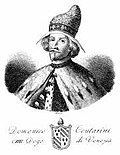 | Domenico II Contarini
(28 January 1585 – 26 January 1675) | 16 October 1659 – 26 January 1675 | Age 74/89 | |
| 105 |  | Nicolò Sagredo
(8 December 1606 – 14 August 1676) | 6 February 1675 – 14 August 1676 | Age 68/69 | |
| 106 |  | Alvise Contarini
(24 October 1601 – 15 January 1684) | 26 August 1676 – 15 January 1684 | Age 74/82 | |
| 107 |  | Marcantonio Giustinian
(2 March 1619 – 23 March 1688) | 26 January 1684 – 23 March 1688 | Age 64/69 | |
| 108 | 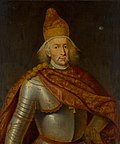 | Francesco Morosini
(26 February 1619 – 16 January 1694) | 3 April 1688 – 16 January 1694 | Age 69/74 | |
| 109 | 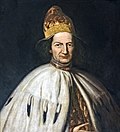 | Silvestro Valier
(28 March 1630 – 7 July 1700) | 25 February 1694 – 7 July 1700 | Age 63/70 | |
| 110 |  | Alvise II Mocenigo
(3 January 1628 – 6 May 1709) | 17 July 1700 – 6 May 1709 | Age 72/81 | |
| 111 |  | Giovanni II Cornaro
(4 August 1647 – 12 August 1722) | 22 May 1709 – 12 August 1722 | Age 61/75 | |
| 112 | 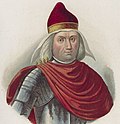 | Sebastiano Mocenigo
(29 August 1662 – 21 May 1732) | 24 August 1722 – 21 May 1732 | Age 59/69 | |
| 113 |  | Carlo Ruzzini
(11 November 1653 – 5 January 1735) | 6 June 1732 – 5 January 1735 | Age 78/81 | |
| 114 |  | Alvise Pisani
(1 January 1664 – 17 June 1741) | 17 January 1735 – 17 June 1741 | Age 71/77 | |
| 115 |  | Pietro Grimani
(5 October 1677 – 7 March 1752) | 30 June 1741 – 7 March 1752 | Age 63/74 | |
| 116 | 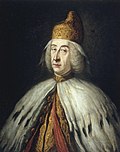 | Francesco Loredan
(9 February 1685 – 19 May 1762) | 18 March 1752 – 19 May 1762 | Age 67/77 | |
| 117 | 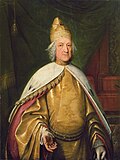 | Marco Foscarini
(4 February 1696 – 31 March 1763) | 31 May 1762 – 31 March 1763 | Age 66/67 | |
| 118 | 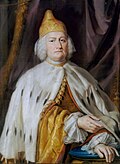 | Alvise Giovanni Mocenigo
(19 May 1701 – 31 December 1778) | 19 April 1763 – 31 December 1778 | Age 61/77 | |
| 119 |  | Paolo Renier
(21 November 1710 – 13 February 1789) | 14 January 1779 – 13 February 1789 | Age 68/78 | |
| 120 | 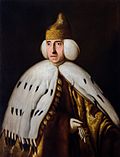 | Ludovico Manin
(14 May 1725 – 24 October 1802) | 10 March 1789 – 12 May 1797 | Forced to abdicate by Napoleon. Age 63/71 at abdication/77 at death | |














































































































